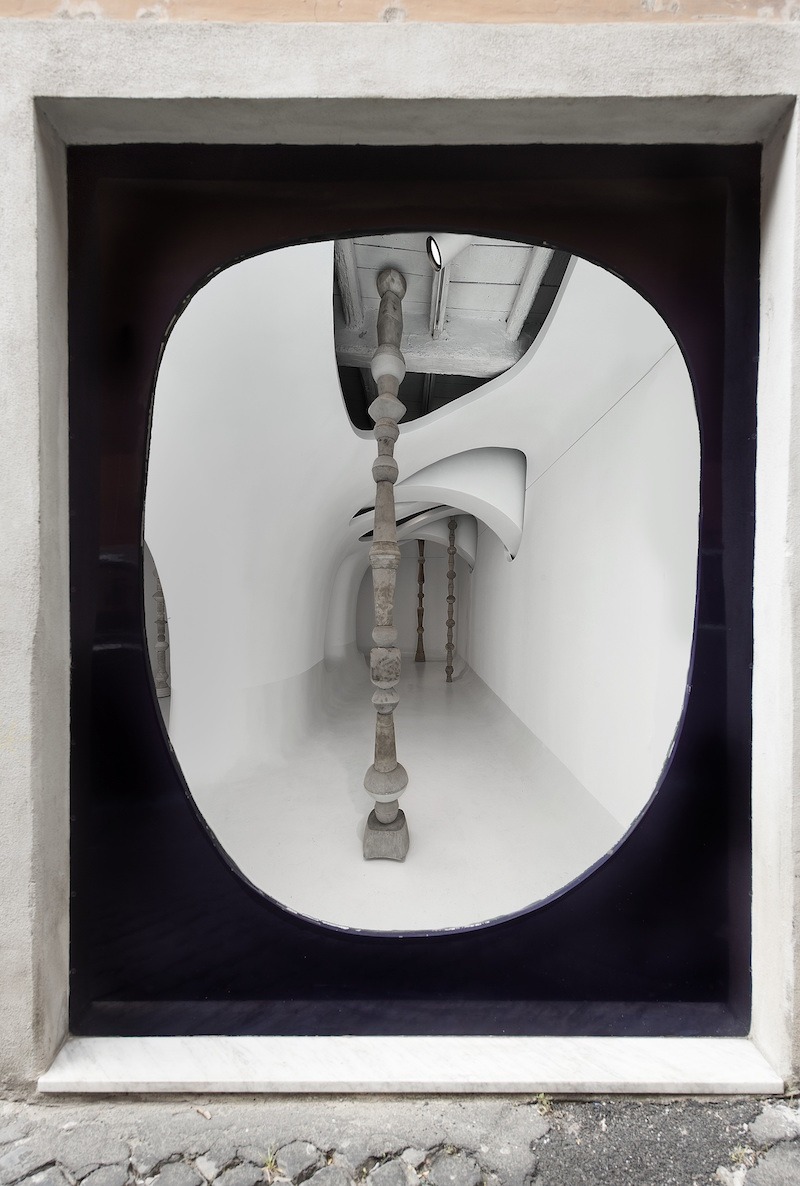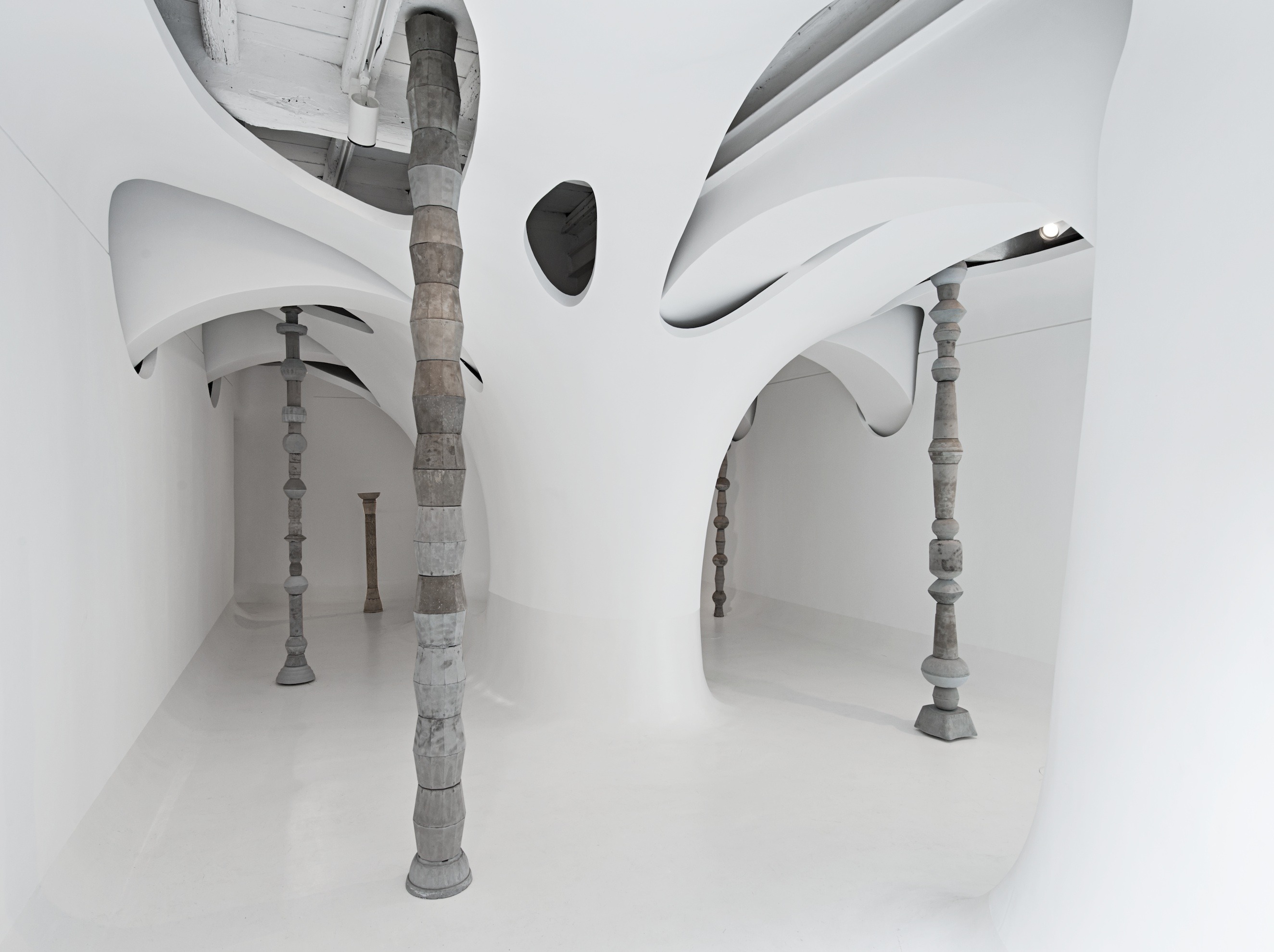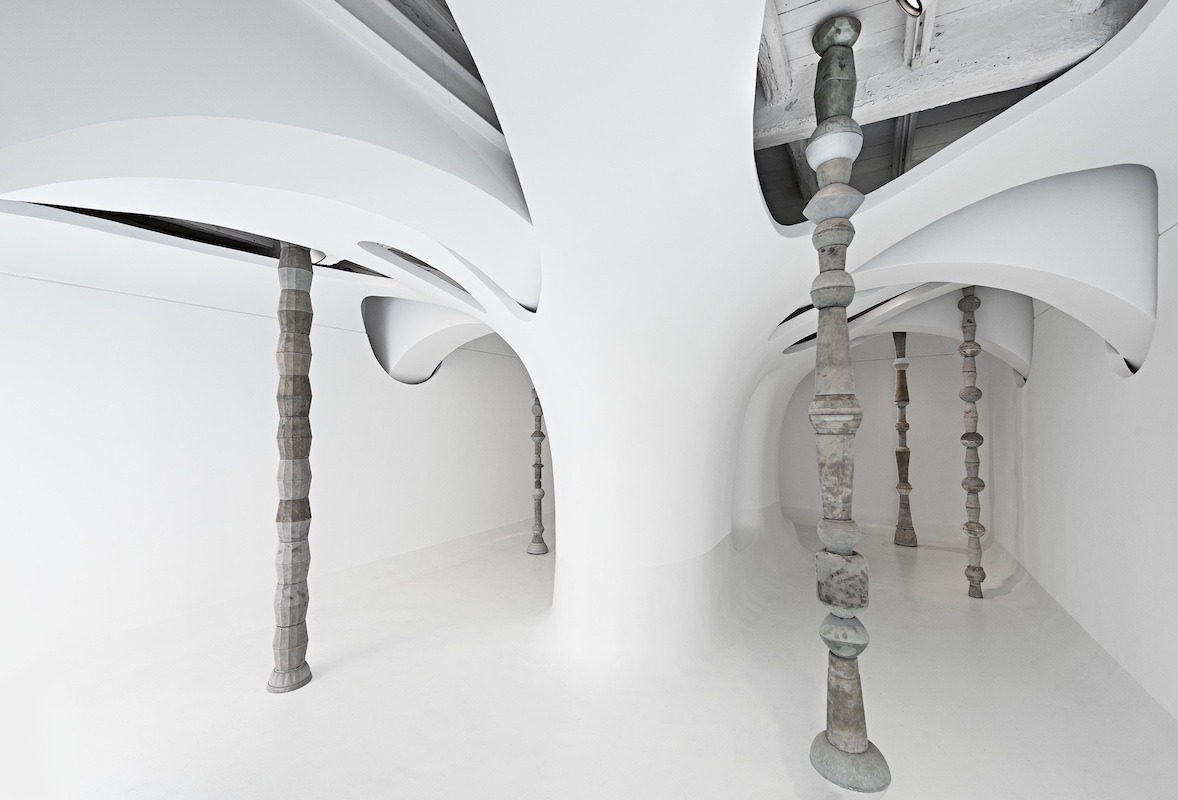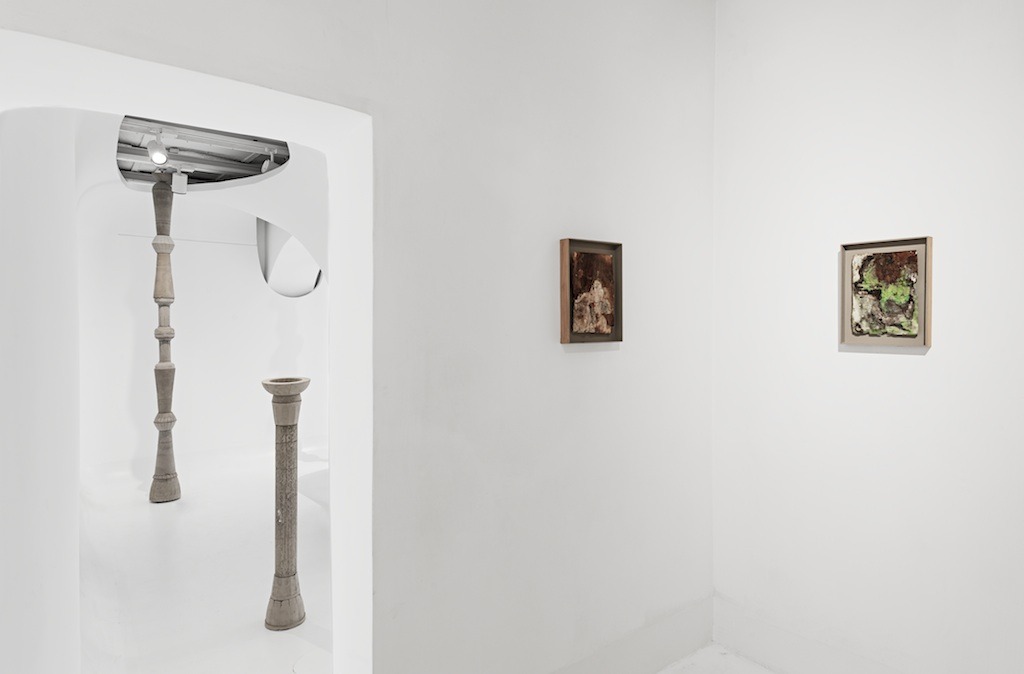Leonid Tsvetkov. Disturbances
Ex Elettrofonica, Rome. 22 March-30 May 2014
On Friday March 21st 2014, the Ex Elettrofonica Gallery presented Disturbances, a site specific project by Leonid Tsvetkov, curated by Manuela Pacella.

Disturbances is the natural evolution of Everyday Downfall, the work realized by the artist during his period of residency at the American Academy in Rome, presented to the public in February 2013.
Everyday Downfall began from the interest that Tsvetkov has always had in the archaeological find as a material expression of habits and customs of the past and, above all, as a key to reading what today might potentially remain and become finds for archaeologists of the future. The primary inspiration was Monte Testaccio, a place the artist described as “a landscape of garbage”. The fascinating aspect of Monte Testaccio lies not only in the fact that it is made up of amphora fragments from the second and third centuries AD that originated from Spain, but that today this dump is held to have a high aesthetic – as well as archaeological – value.
Starting from this premise, the artist began collecting scrap materials of daily life, especially food packaging. Concrete moulds of these containers (of various shapes and sizes) were then displayed on the ground of the atrium of the American Academy, in close dialogue with the archaeological finds kept there and creating an ideal urban landscape. After the exhibition, Tsvetkov continued his project by “abandoning” these moulds in all the archaeological areas of Rome and its environs.
For Ex Elettrofonica the artist has devised an installation that will cut the gallery space vertically, through the insertion of groups of columns of various dimensions and heights, created by placing the concrete moulds of the most disparate industrial scraps one on top of another. These vertical incisions force the visitor to walk the exhibition space in a conscious way and to observe the columns as artistic productions made with what normally we don’t look at but throw away.
As well as the installation, Tsvetkov will display some of the works on paper that he made in Rome between 2012 and 2013, whose basis consisted of floor plans and architectural reliefs of places like the Vatican, submitted then to a process of electroplating. Through this process the artist renders the original paper no longer legible and creates new landscapes. This series of works confirms the modus operandi of Tsvetkov, who likes to operate on his materials just enough so that they can reveal already existing chemical or natural processes.
The exhibition is organized in collaboration with AlbumArte space | projects for contemporary art, which hosted the artist within the studio residency program 2014.

Leonid Tsvetkov (1980, Novgorod, Russia). Selected exhibitions: 2014, WAEN, Assumburg, Hemskerk, NL;Hasselt-Genk Z-33, Hasselt, BE; Sammlung Ludwig, Bamberg, DE; 2013, Cinque Mostre, American Academy in Rome, IT; 2012, Moment of Now, 361Roma Associazione Culturale, Rome, IT; Back to the Future, CBKU, Utrecht, NL; 2011, What’s Next, Museum Tot Zover, Amsterdam, NL; MärklinWorld, Kunsthal KAdE, Amersfoort, NL; Muro Tenente Archeological Park, Apulia, IT; Control Symposium presentation, KNAW, Amsterdam, NL; 2008, Metro Poles: Art in Action, Bronx River Art Center, New York, NY; Thursday The 12th, Kate Werble Gallery, New York, NY; Blank, Beijing, China; 2007, Habitant, HGallery, Bangkok, Tailand; Sculpture Dimensions and Field Variable, San Vito al Tagliamento, IT; Carte Blanche, Elizabeth Dee Gallery, New York, NY; Blank, Ke Contemporary Center for the Arts, Shanghai, China; Horizon, EFA Gallery, New York, NY; Short Stories, Photographs 1890-2006, Macy Art Gallery, New York, NY; 2006,The Armory Show, Represented by Jack Tilton Gallery New York, NY; School Days, Jack Tilton Gallery New York, NY; 2005, Blackboards, Yale University School of Management, New Haven, CT. Awards and Scholarships: 2013, Internationales Künstlerhaus Villa Concordia Stipendium; Mondriaanfonds Basis Stipendium; 2012,Royal Dutch Fellow. American Academy in Rome. AFAAR 2012-13; 2010, Van Bijleveltstichting Award; 2009, Prins Bernhard Cultuurfonds, Amsterdam, Netherlands; 2006, Ely Harwood Schless Memorial Fund Prize, Yale University; 2005, Robert Scheolkopf Traveling Scholar, Yale University; 2003, Best of SUNY (Art), Chancellor Scholarship; 2001, Lancelotte and Richard Laster Scholarship; 2000, Rochester Art Supply Sponsors Award; 1999, North American Collegiate Chess Championship. Top Board.



The “in-between” world of Leonid Tsvetkov
Observing Leonid Tsvetkov at work, like studying his artistic production, requires the same insight that the artist puts toward the places where he works. His is a way of looking at things which is at the same time attentive to the smallest details and aware of the whole to which they belong. This continuous transfer from the particular to the whole and vice versa places our perception in an incessant and laborious state of alert, because one single answer cannot be found, but rather many other questions arise.
The issues raised by Tsvetkov are numerous and belong to all of us. His is an inquiry between various styles and, to realize his works, he makes use of philosophical, architectonic, archaeological, physical and chemical knowledge.
“The ‘in between’ space of the positive and negative, of action and thought, of art and life, is where I find meaning and learn to think”, to quote the artist himself.
That intermediary space is also a physical and cultural space in the artist’s life: Amsterdam, geographically halfway between Russia, or rather the former Soviet Union, where he spent the first 14 years of his life, and the United States, where he resided for the 14 years after that.
In 2009, at the end of his first stay in Holland, he created Space Between, which is much more than a work of art. His studio becomes a reflective place on finding himself exactly halfway between two completely different cultures, where he tries to find the right balance between natural and artificial, between freedom and constraint.
Tsvetkov chose Amsterdam for his residence. There he feels that he is at the halfway point between two opposites. It is the base from where he then leaves for long stretches of time abroad. Travelling continuously and collecting experiences is part of his method.
In Rome, in residence at the American Academy in 2012-2013, he completed chiefly two series of works, highly characteristic of his methodology.
The first is Everyday Downfall, displayed in the atrium of the Academy’s villa on the Janiculum hill. The work, as it is displayed, is made up of the juxtaposition of the marble ruins already present there with cement casts of food containers, created by the artist. The casts, the “cementation” of an empty container, discarded and useless, obviously brings various meaningful connotations with it, not the least of which is a new aesthetic value given to the object of which even the brand of manufacture, made more visible, becomes interesting.
To realize this work the artist wove together a series of social relationships with the territory in his research of materials. After the exhibition he then “abandoned” the casts adjacent to various archaeological ruins in Rome and its surroundings, wanting to highlight, in the end, the familiarity between them and wanting to let nature slowly make those industrial forms more organic.
The project was born from the observation of Monte Testaccio in Rome, a place of incredible charm but, essentially, simply an artificial hill created with discarded amphorae coming from Spain (today very valuable), that at the time were used as containers for oil.
It is clear that the intervention of the artist is, ultimately, minimal. After studying and observing the territory, it’s limited to carrying out actions of “disturbance” to encourage reflection. Disturbance is everywhere and it is perceived primarily when one has an other, external way of observing. Disturbance is the very waste that we produce but it is also nature, slowly taking back what man has taken away from it. Rome is exemplary in this sense. It is, I would say, disturbing.
The term Disturbances, chosen by the artist as the title of the site specific project for Ex Elettrofonica, is used by archaeologists to define any activity that can damage an archaeological site. This leads to the thought, ultimately, that even simply walking in Rome creates a profound disturbance to ancient civilizations.
Tsvetkov, as a continuation of the project undertaken last year in Rome, has created an installation that cuts the space of the gallery vertically. The idea of verticality came about immediately once he entered the environmental alcove so characteristic of the Trasteverine space. There are columns of various dimensions and heights, realized by placing, one over the other, cement casts of waste, mainly of food containers. These columns refer to the immense ones found in Rome, which have lost their function of support and have often been reconstructed using different materials, like patchwork quilts. There is also a reference to the Brancusian Infinity, to his desire to reach a celestial summit through repetition. There is, very simply, the beauty of some forms having become “positive”, no more containers but contents, of solid and aesthetic form so that it is hard to recognize the original function.
For example, for the A4 series exhibited and begun in Rome in 2012 (the second group of works created at the American Academy) the artist observes what happens. In this case prints of historical and powerful places of the city were put under processes of electrolysis, where metal objects dissolve and leave visible traces on cards. Thus they end up forming landscapes in place of architecture; again, that space between the two worlds, natural and artificial.
Reuse, interdisciplinarity, continuous movement, the creation of works that, one by one, can continuously evolve and transform – all these make Leonid Tsvetkov a highly representative artist of our time and it’s no coincidence that he referred to some enlightened words from Professor Giacomo Marramao (professor of Political Philosophy at Roma Tre University) at a recent conference at the Swiss Institute of Rome:
“Every historical innovation, every revolutionary innovation in history has been preceded by a fertile conspiracy of languages; a fruitful conspiracy of artistic, scientific, and philosophical styles.”And, later: “The passage from linguistic turn to the spatial turn that has modified enormously not only our conception of space and therefore of global and local but has changed the cognitive tools of geographers completely. Geography has become an avant-garde discipline. The discipline that puts into discussion all maps that think of giving importance to global spatiality; the end of the capacity of maps to give value to what happens; the elusiveness of the places where the common comes together, where forms of life gain experience.” [1]
To abandon that sense of frightening frustration in the face of the idea of a consciousness of the whole; to reeducate oneself towards a outward view of things; to give oneself the necessary time: [2] I think this is, ultimately, the biggest lesson that should be taken when faced with an artist of Leonid Tsvetkov’s calibre.
Manuela Pacella
[1] Extracts of Professor Giacomo Marramao’s participation during the debate Studio Roma. Arte, conoscenza, educazione. Swiss Institute, Rome, 27 February 2014.
[2] Synthetic excerpt taken from the conclusive participation of Cesare Pietroiusti during the debate cited above.